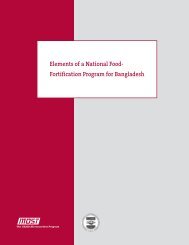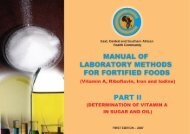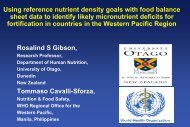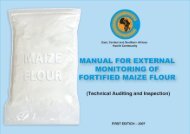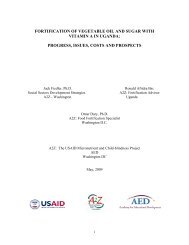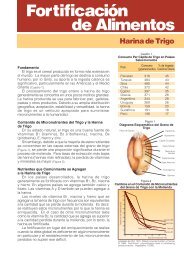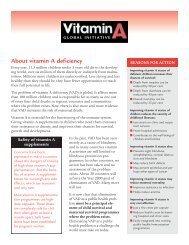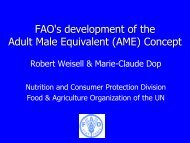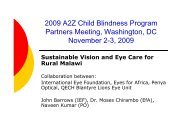manual of methods for determining micronutrients in fortified foods
manual of methods for determining micronutrients in fortified foods
manual of methods for determining micronutrients in fortified foods
Create successful ePaper yourself
Turn your PDF publications into a flip-book with our unique Google optimized e-Paper software.
C. Chromatography<br />
10. Start HPLC system and allowto warm up and equilibrate <strong>for</strong> m<strong>in</strong>imum <strong>of</strong> 1 hour with mobile phase<br />
flow<strong>in</strong>g. Flow rate should be 1.0 mL/m<strong>in</strong>.Use the chromatographic conditions <strong>in</strong>dicated <strong>in</strong> the table<br />
below.<br />
Parameter<br />
Condition<br />
Column<br />
XBridge C18 Column, 5 µm, 4.6x 150 mm<br />
Flow<br />
1.0 mL/m<strong>in</strong><br />
Fluorescence<br />
Detector<br />
Excitation wavelength: 370 nm; Emission wavelength: 430 nm<br />
Injection volume 100 µL<br />
11. Adjust flow to 1 mL/m<strong>in</strong> and <strong>in</strong>ject the work<strong>in</strong>g standard solution <strong>in</strong> duplicate, <strong>in</strong> the follow<strong>in</strong>g<br />
order 0.05 mg/L, 0.1 mg/L and 0.2 mg/L. if necessary, <strong>in</strong>crease the flow to 1.5 mL/m<strong>in</strong>.<br />
12. Inject the samples under the same conditions as the thiam<strong>in</strong>e standard and <strong>in</strong>tersperse with standard<br />
solution <strong>in</strong>jections after every n<strong>in</strong>e samples to ensure accurate quantification.<br />
VIII. Calculations<br />
1. Calculate the equation <strong>of</strong> the standard curve us<strong>in</strong>g Area (y) vs. concentration-mg/L (x) <strong>for</strong> the three<br />
standard concentrations <strong>in</strong>jected. An equation similar to the follow<strong>in</strong>g will be obta<strong>in</strong>ed:<br />
y =1E08x −144138<br />
2. The correlation coefficient (r) should be 0.999 or above.<br />
3. Calculate the Thiam<strong>in</strong>e concentration<br />
€<br />
(mg/L) <strong>in</strong> the <strong>in</strong>jected solution us<strong>in</strong>g the regression equation.<br />
4. Us<strong>in</strong>g the concentration <strong>of</strong> sample <strong>in</strong> mg/L, calculate Thiam<strong>in</strong>e concentration <strong>in</strong> the sample us<strong>in</strong>g<br />
the follow<strong>in</strong>g equation.<br />
Where:<br />
Thiam − <strong>in</strong>e(<br />
mg / kg<br />
) = C<br />
s<br />
Vi<br />
x<br />
W<br />
s<br />
Parameter Explanation Value<br />
C s<br />
Concentration <strong>of</strong> Thiam<strong>in</strong>e <strong>in</strong> the sample (mg/L)<br />
obta<strong>in</strong>ed from the regression equation.<br />
?<br />
V i<br />
Initial volume (mL) 100<br />
W s<br />
Sample weight (g). Around 10 g<br />
- 46 -





